Key takeaways:
- Gender equality advocacy is centered on creating equal rights and opportunities, challenging societal norms, and sharing personal stories to inspire collective action.
- Grassroots leadership is crucial as it originates from those directly affected by inequality, fostering an inclusive environment and promoting solidarity among community members.
- Collaboration and storytelling are powerful tools in advocacy, allowing diverse voices to unite and enrich the movement for gender equality.
- Continuous education, leveraging social media for engagement, and prioritizing self-care are essential strategies for effective advocacy and sustainable involvement.
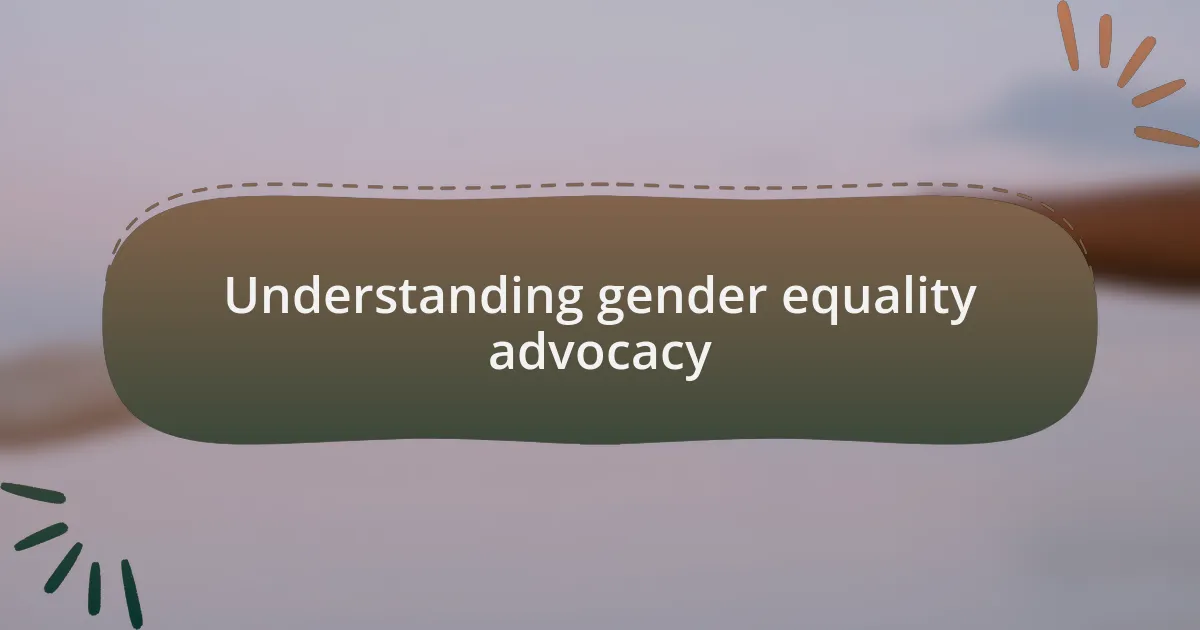
Understanding gender equality advocacy
Understanding gender equality advocacy can often feel overwhelming, yet it’s fundamentally about creating a world where everyone has the same rights and opportunities, regardless of gender. I remember attending a local workshop where the speaker shared her journey from feeling powerless to becoming a staunch advocate; her passion was palpable. Isn’t it inspiring to think about how one person’s determination can spark change in an entire community?
At its core, gender equality advocacy challenges societal norms and works toward dismantling barriers that restrict individuals based on gender. I’ve seen firsthand during community meetings how addressing these norms can lead to powerful discussions among attendees, urging them to reflect on their own biases and experiences. Have you ever wondered how many perspectives remain unheard simply because they don’t conform to established gender roles?
This advocacy isn’t just about statistics or policies; it’s about personal stories and shared experiences that highlight the urgency of the cause. In a recent event, a participant shared her struggles with workforce discrimination, and the room fell silent as her story resonated with many. Isn’t it these emotional connections that fuel our commitment to fight for equality together?
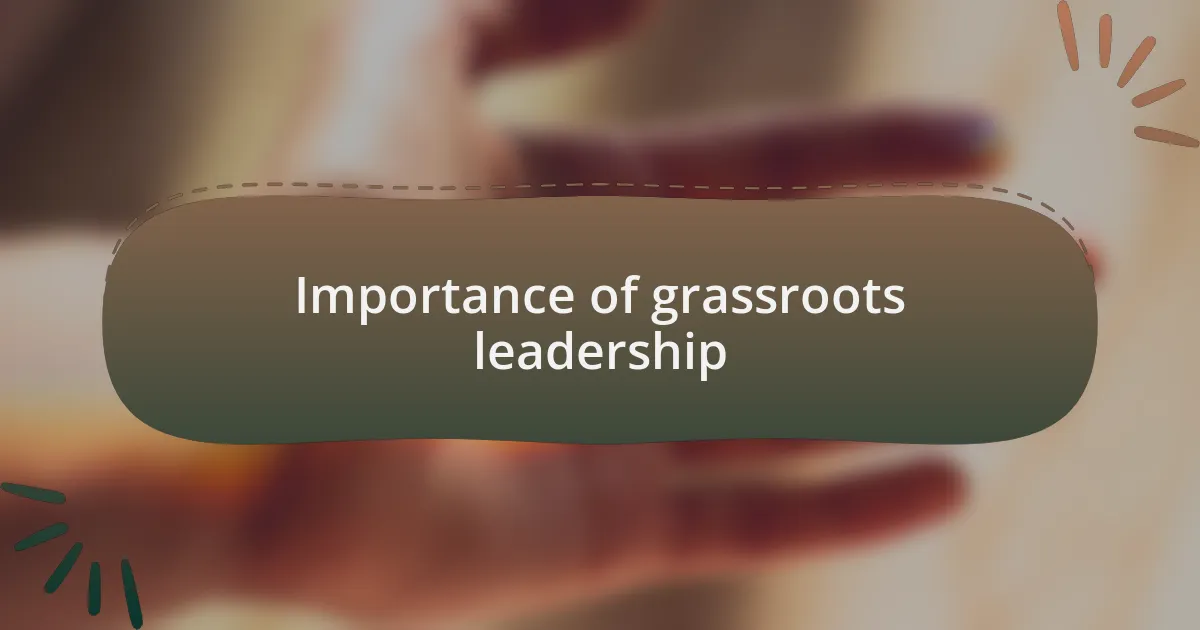
Importance of grassroots leadership
Grassroots leadership plays a crucial role in the fight for gender equality, as it often springs from the very communities that are impacted by inequality. I recall a neighborhood meeting where a local leader, fueled by her own experiences with discrimination, led an empowering discussion that illuminated the unique struggles faced by women in our area. How powerful is it to witness someone channeling their pain into action that uplifts others?
These leaders are vital because they possess an intimate understanding of the issues at hand; they know what resonates with those they represent. For instance, I met a grassroots organizer who once grappled with gender bias in her workplace. Her efforts to create support networks encourage others to stand up against similar challenges. Isn’t it incredible how grassroots leaders not only advocate for change but also cultivate an environment of solidarity?
Moreover, grassroots leadership fosters an inclusive space where everyone feels valued and heard. I remember a campaign driven by local advocates that emphasized the voices of marginalized women who often face double discrimination. This approach not only amplifies their stories but also pushes the movement forward. Have you ever thought about how every individual’s story contributes to a larger narrative of progress?
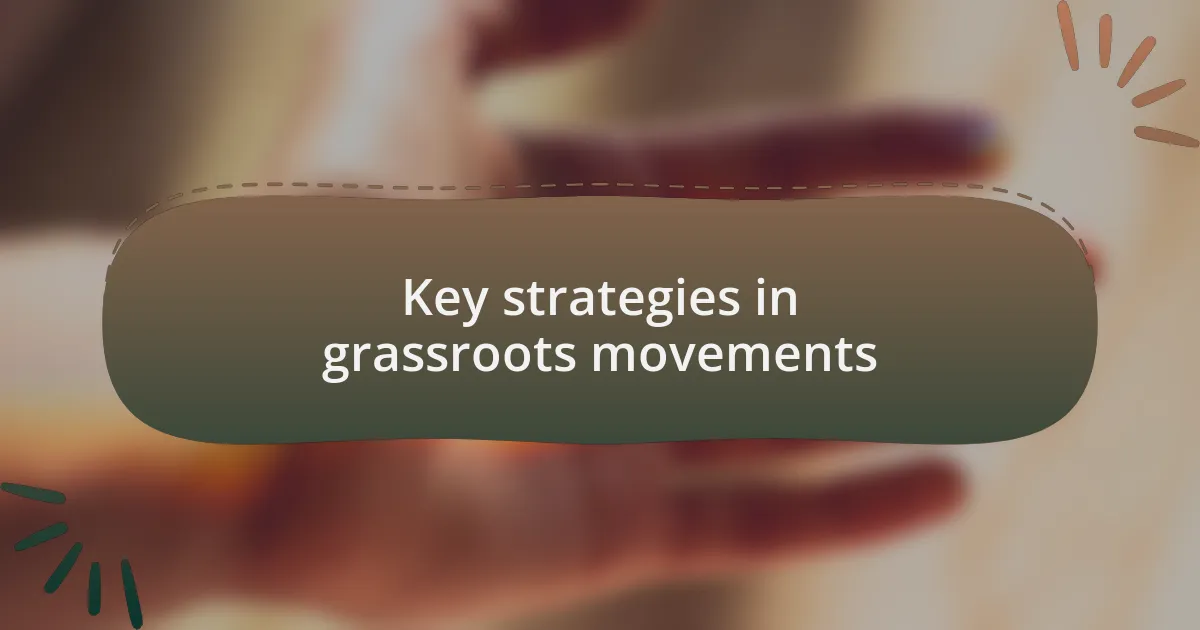
Key strategies in grassroots movements
Grassroots movements thrive on the power of community engagement, often utilizing local knowledge to shape their strategies. I’ve seen how organizing events that bring together diverse voices can spark meaningful conversations. For example, a small workshop I attended revealed underlying issues of gender-based violence that many were too shy to discuss openly at first. This kind of dialogue is essential; it transforms silence into action.
Another effective strategy is the creation of calculated alliances with other movements and organizations. When I partnered with environmental advocates, we discovered overlapping interests in intersectional equality, highlighting how social justice is interconnected. I vividly remember how a joint campaign focused on urban women’s rights not only broadened our reach but also enriched our understanding of each other’s struggles. How amazing is it when different causes unify for a common purpose?
Moreover, maintaining accessibility in communication channels is a cornerstone of grassroots successful strategies. I recall working with leaders who implemented multilingual resources to engage non-English speaking women in our community. This push for inclusivity made a significant impact—it invited more women to participate and share their experiences. Isn’t it empowering to realize that when we break down barriers in communication, we open the door to a richer tapestry of voices and ideas?
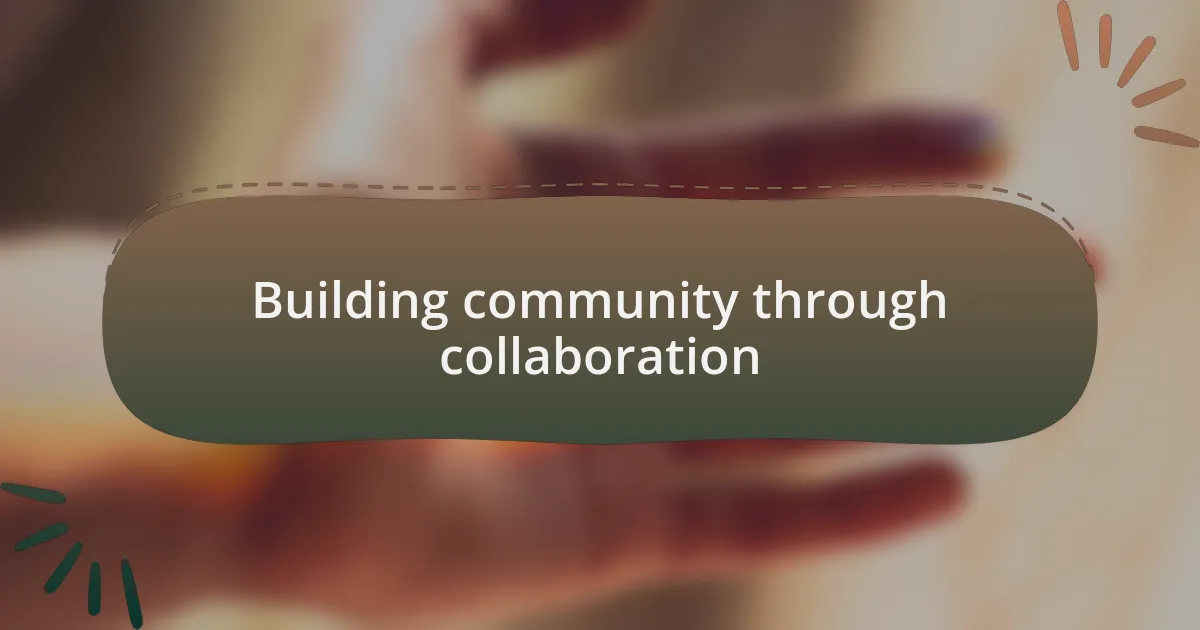
Building community through collaboration
Building community through collaboration is a powerful experience I’ve witnessed firsthand. I remember coordinating a community mural project where everyone contributed their stories about gender equality. Seeing people from different backgrounds come together, sharing their visions and struggles, created a palpable sense of unity. Isn’t it fascinating how shared goals can transform individual stories into a collective narrative?
When I attend collaborative meetings, I often notice the initial hesitance of participants, overshadowed by the fear of being vulnerable. Yet, witnessing that gradual shift where everyone starts to voice their thoughts is truly uplifting. I find that when we create safe spaces for dialogue, we not only foster deeper connections but also enable transformative change. Reflecting on such moments makes me appreciate the profound impact of genuine collaboration.
Collaboration doesn’t always mean formal agreements or procedures. Sometimes, it’s as simple as reaching out for coffee with a fellow activist to brainstorm ideas. I once did this with a local leader, and we uncovered mutual challenges we hadn’t acknowledged before. That informal exchange sparked a series of joint initiatives, illustrating that even casual interactions can lay the groundwork for meaningful community development. Who would have thought over a cup of coffee could lead to such impactful collaborations?
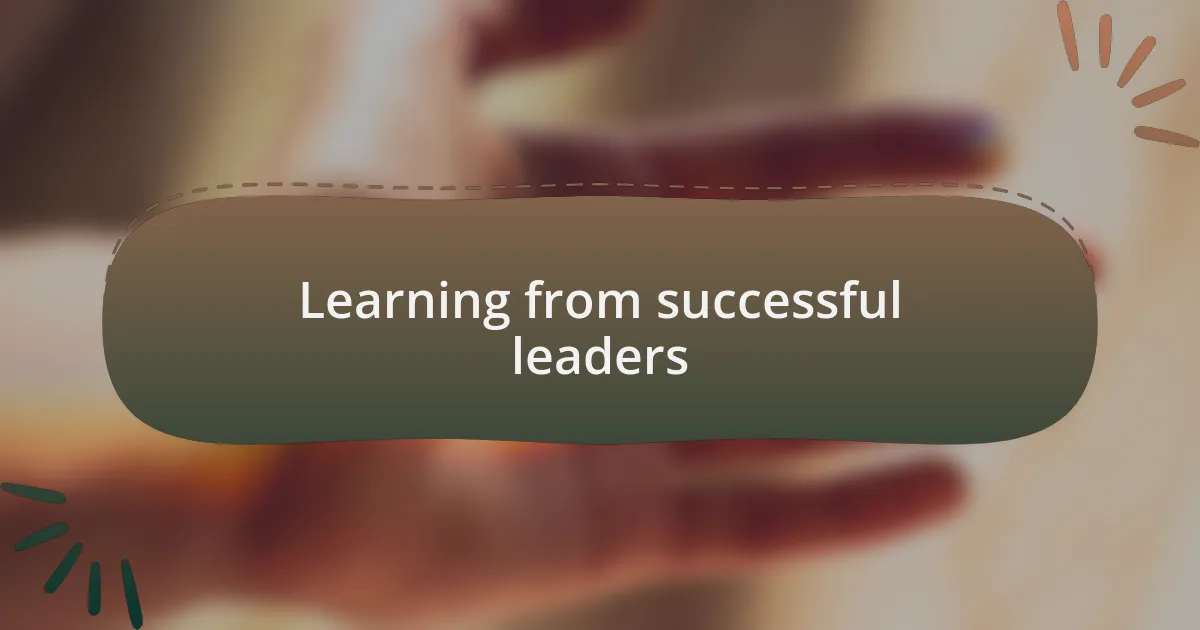
Learning from successful leaders
Learning from successful leaders has enriched my understanding of effective advocacy. I recall attending a workshop led by a seasoned grassroots organizer who shared her journey. She emphasized the importance of resilience in the face of setbacks. Listening to her story, I couldn’t help but reflect on my own experiences with failure. How often do we let obstacles define our next steps, rather than learning from them?
Another lesson that stands out is the power of storytelling. At a community event, one leader shared her harrowing yet hopeful tale of overcoming gender-based violence. The emotional weight of her words resonated deeply with everyone present. I realized then that personal narratives can ignite passion and drive action in ways mere statistics often fail to achieve. Have you ever felt so moved by someone’s story that it sparked a change in your perspective?
Finally, the significance of mentorship cannot be overstated. I once worked alongside a mentor who tirelessly guided me through various advocacy strategies. Her willingness to invest her time and energy made all the difference in my journey. It got me thinking: how can we all become mentors to lift others in this fight for equality? By sharing knowledge and resources, we’re not just building our capacity; we’re fostering a network of empowered advocates ready to create change.
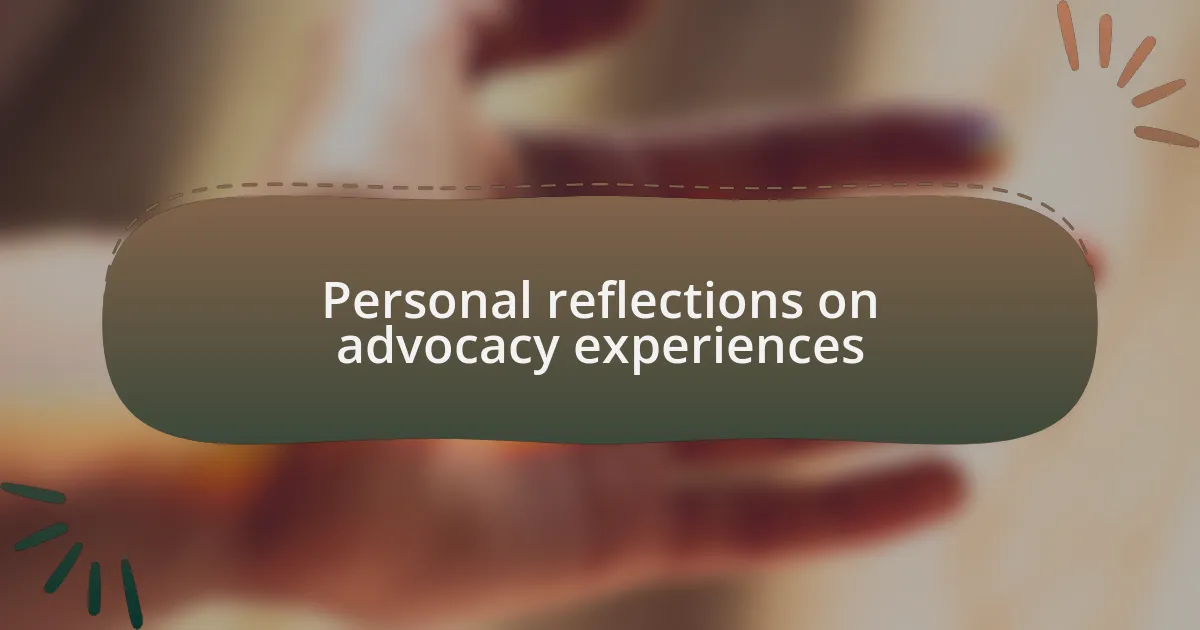
Personal reflections on advocacy experiences
In my advocacy journey, I’ve encountered moments that tested my commitment. I remember a particularly challenging campaign where our team faced intense pushback on our proposed policy changes. It was disheartening at times, yet I learned that these difficulties can often reveal the depth of our passion. Have you ever felt a surge of resolve when faced with a roadblock? I realized that embracing discomfort is crucial to growth and transformation.
One experience that still lingers with me was a rally I organized, where I stood in front of a diverse crowd, nervously clutching my notes. But as I saw people nodding and connecting with my message about gender equality, the nervousness faded into exhilaration. It dawned on me that vulnerability can be a powerful tool in advocacy; it fosters connection and understanding. How many times have you shared your own story and witnessed the impact it had on others?
Another reflection centers on the beauty of collaboration. During a project with a coalition of local organizations, we faced differing opinions, but instead of becoming obstacles, those conversations became opportunities for learning. Listening actively to each other’s perspectives enriched our approach and created a deeper sense of community. Isn’t it incredible how diverse viewpoints can lead to a fuller understanding of the issues we fight for? My experience in that coalition showed me that unity in diversity is not just a concept; it’s a necessity in our advocacy efforts.
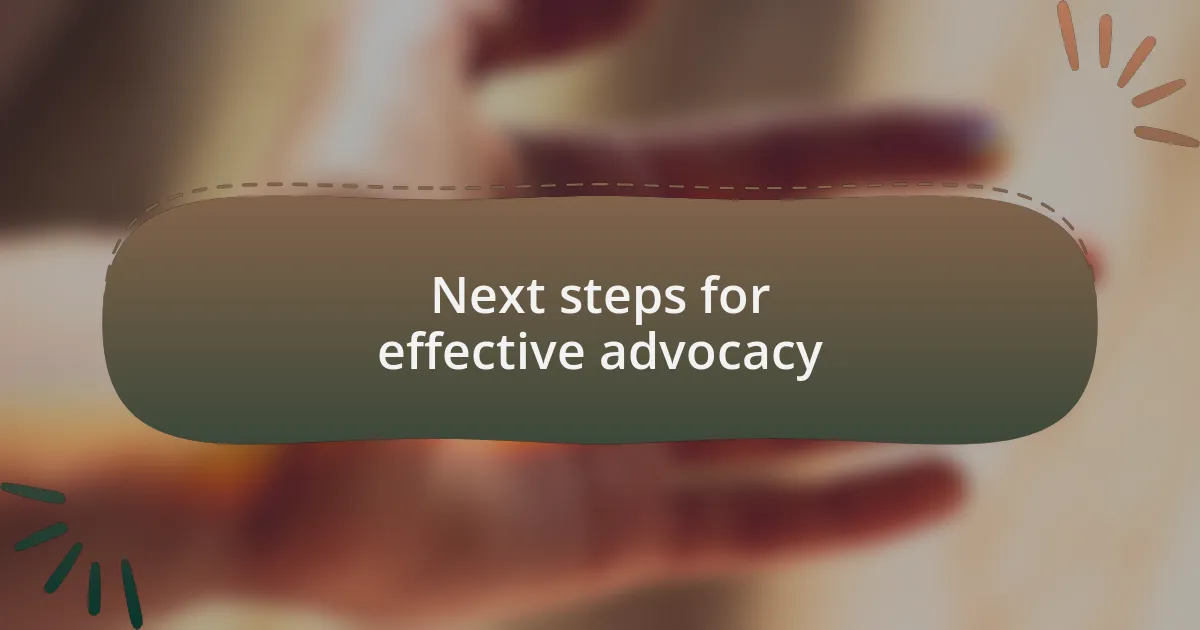
Next steps for effective advocacy
To take our advocacy efforts to the next level, I believe it’s essential to continuously educate ourselves. In a workshop I attended, the facilitator urged us to delve deeper into the historical context of gender issues. This exploration helped me comprehend the systemic barriers we face today and ignited a drive within me to advocate for policy changes that address these root causes. Have you ever felt like understanding the ‘why’ behind a problem gives you new vigor to tackle it?
Next, I think it’s vital to leverage social media as a tool for grassroots engagement. After sharing personal stories and experiences on social platforms, I noticed an increase in dialogue among my followers. It highlighted to me how stories resonate and mobilize support. Have you considered how your own narrative could inspire someone else? It makes sense that the more we share our journeys, the more we empower others to join the fight for gender equality.
Lastly, self-care should not be overlooked in our advocacy roadmap. I once pushed myself through consecutive events without a break, only to burn out. That experience taught me that sustainable advocacy requires a balance between giving and receiving. What strategies do you have in place to recharge? Remember, our effectiveness as advocates is directly tied to our well-being. Prioritizing self-care allows us to return to the cause with renewed energy and passion.